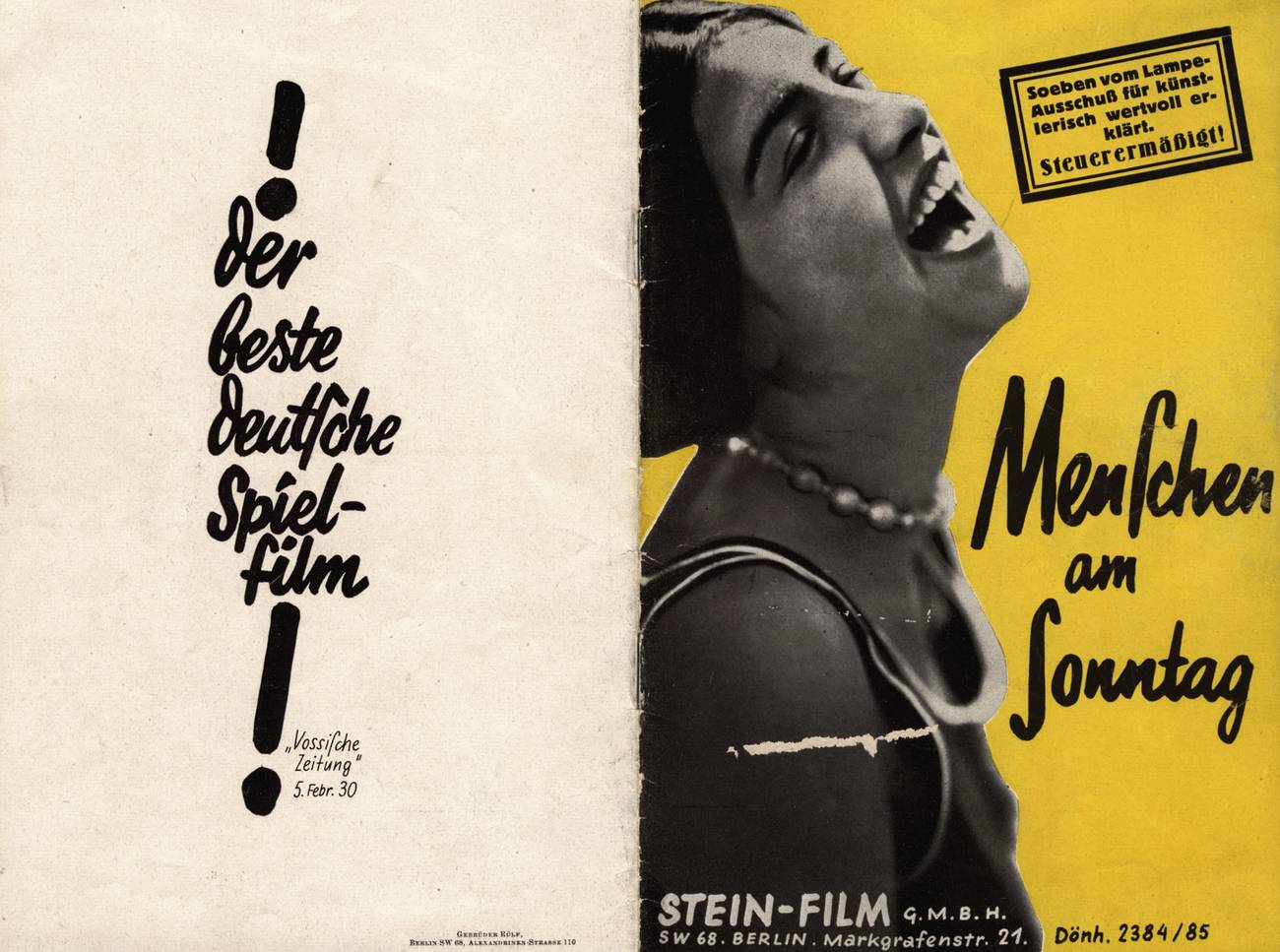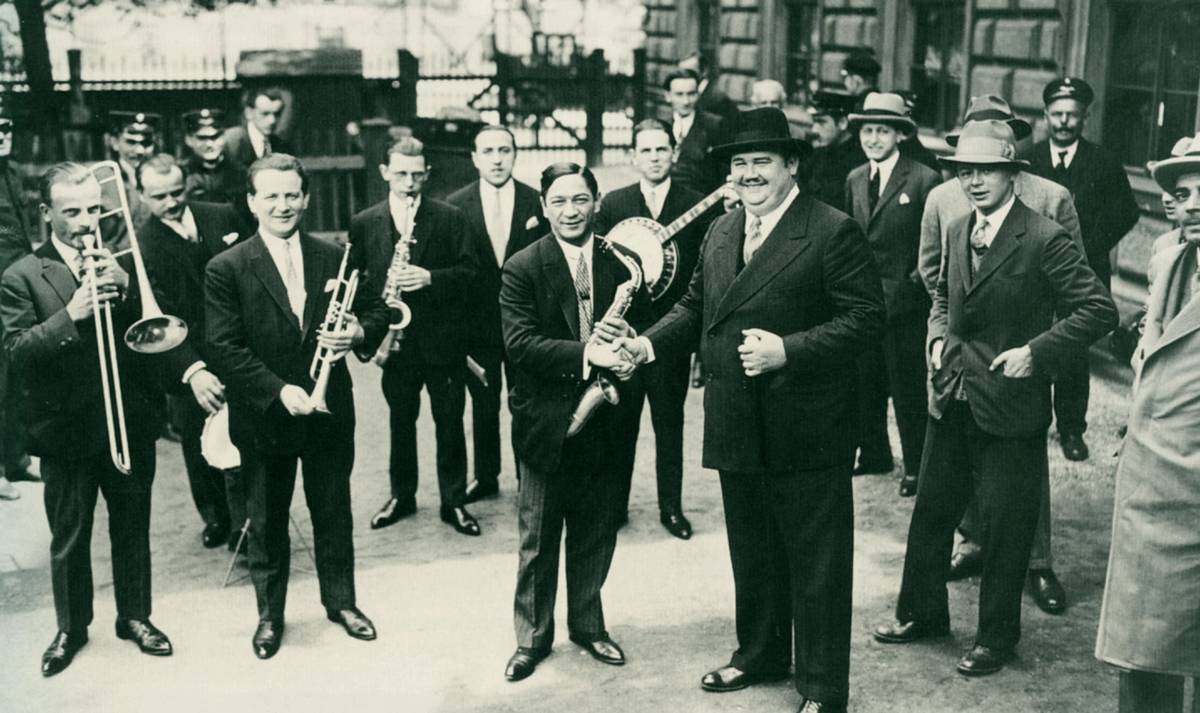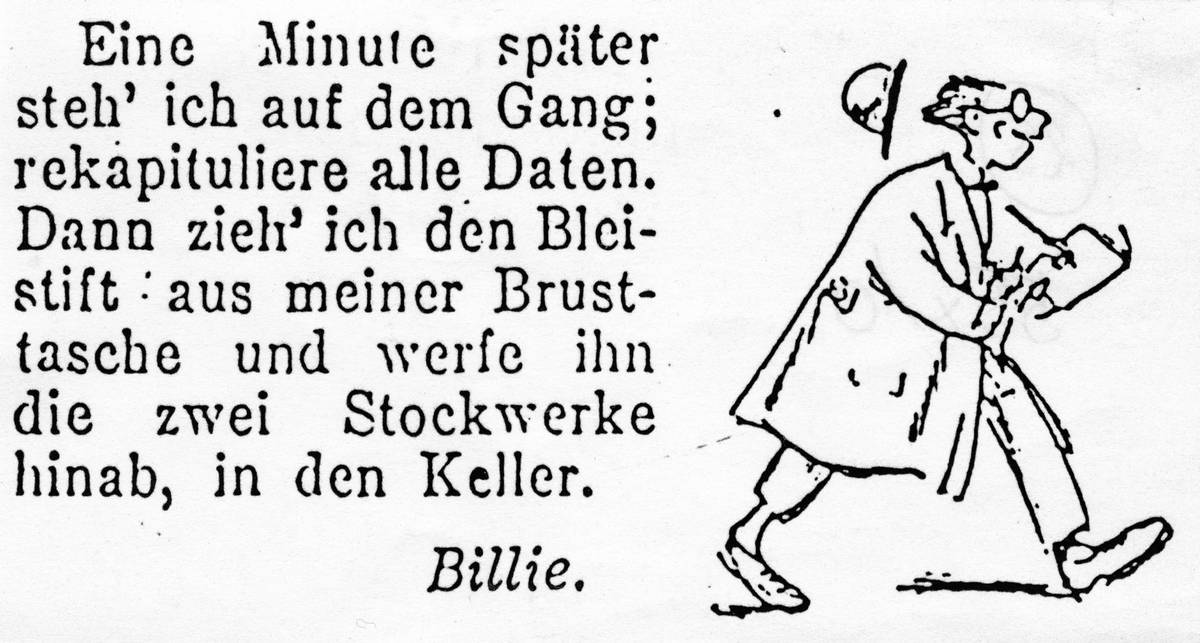Billy Wilder in Weimar Berlin
A new compilation of his early writings showcases the voice of one of golden age Hollywood’s cleverest stars



Of all the artists who washed up in Hollywood during the great wave of refugees from Nazism in the 1930s, it was Billy Wilder, more than any other, who not only made Hollywood his own but helped to remake it. The films of the writer-director—Double Indemnity (1944), Sunset Blvd. (1950), and Some Like It Hot (1959), to limit the list to save space—are as well-known and oft-referenced as any in the motion picture canon, their signature scenes still worshipfully cited and routinely ripped off by his descendants.
Off-screen, Wilder’s presence looms nearly as large as a sage and wit. After retiring from active filmmaking in 1981, the old pro gave advice to aspiring screenwriters, aphorisms that came to take on the authority of Holy Writ (“If your second act curtain doesn’t work, your film doesn’t work”). Earlier, actually as soon as he mastered enough English to crack wise, he was famous around town for utterances as quotable as anything he put into the mouths of his actors. (Personal favorite: While working for the OWI in postwar Germany, Wilder responded to an ex-Nazi actor who wanted to play Christ in a production of The Passion Play with a counteroffer: “Only if we can use real nails.”)
Yet Wilder’s place in the American film canon has not always been so obvious, even to committed cineastes. In The American Cinema: Directors and Directions 1929-1968, the go-to sourcebook for Hollywood cinema before the arrival of digital tomato and popcorn icons, film critic Andrew Sarris consigned Billy Wilder to his “less than meets the eye” category, the artistic dungeon reserved for auteur wannabes whose “reputations [are] in excess of their inspirations” and whose “personal signatures” are “written with invisible ink.” Wilder was a poseur “too cynical to believe his own cynicism” and so vapid he was “hardly likely to make a coherent film on the human condition.” Sarris later recanted his bone-headed judgment.

Wilder’s incisive wit, acerbic vision, and commitment to sturdy dramatic scaffolding were already part of his creative portfolio when, in 1934, his fellow exile, the great Ufa director Joe May, first drove him down Sunset Boulevard. The proof is reprinted in Billy Wilder on Assignment, an irresistible collection of articles, profiles, and reviews from Wilder’s salad-und-bratwurst days in Berlin, where he worked as a roving journalist, critic, and scene-maker between 1926 and 1930. Culled from two comprehensive volumes of Wilder’s journalism published in Germany, edited by Noah Isenberg and translated by Shelley Frisch, the volume flashes back to the days when the byline was Billie not Billy, the language German, and the voice, even then, unmistakable.
Wilder was always fortunate in his collaborators, and even posthumously his luck still holds. Both the editor and translator have extensive experience prowling the precincts of Weimar Berlin: Film historian Isenberg (We’ll Always Have Casablanca: The Life, Legend, and Afterlife of America’s Most Beloved Movie) is an expert guide to the Berlin-to-Hollywood axis, and Frisch is a veteran translator of German language biographies, most recently Karin Wieland’s 2011 Dietrich & Riefenstahl: Hollywood, Berlin, and a Century in Two Lives (Wilder hung out with Dietrich back in the day but not, alas, with Riefenstahl, so we lack a Wilder witticism on the woman who became Hitler’s favorite filmmaker). Isenberg and Frisch are also unabashed fans. “Affinities between Wilder’s Weimar-era writings and his later film world abound,” remarks Isenberg, and, inevitably, one reads the dispatches from the Weimar Wilder with an eye to the Hollywood Wilder.
Wilder’s all-America first name—Billie, bestowed by a mother smitten with Buffalo Bill—can perhaps be read too easily as predestination. Born in 1906 in the Galician backwater of Sucha, he moved with his family to Vienna at an early age, and, like many transplants, adopted the more fashionable address for his origin story. At 18, he hustled a gig with a local paper, Die Bühne, and was off and typing, composing everything from crossword puzzles to character sketches. Wilder’s format of choice, Isenberg helpfully explains, was the feuilleton, or cultural essay, a kind of New Journalist mix of “reportage and descriptive musings,” that thrived in Central Europe in the late 19th and early 20th centuries. First in Vienna, then in Berlin, he spent the last half of Die goldenen zwanziger Jahre—the golden ’20s—chronicling the sweet life as an enthusiastic participant-observer.

The opening—and best—tale is Wilder’s account of a career interlude that the teller would richly embroider in years to come. While down on his luck in Berlin, Wilder worked as a dancer-for-hire in the ballroom of the swank Hotel Eden, 5 marks a night, plus tips. Young Billie was an unlikely paid escort—Richard Gere he ain’t—but the nattily dressed and cologne-scented charmer was, at least as he told it, a favorite on the treadmill. “I wasn’t the best dancer,” he recalled, “but I had the best dialogue.” If you want to think he did more than the foxtrot with his partners, he will not disabuse you of the notion. “The dancer’s First Commandment is: there can be no wallflowers!” proclaims Wilder’s dance hall monitor, before delivering a line that Hollywood-period Wilder might have penned to bait the Breen office: “He needs to pluck them because that is what he is getting paid for!”
The other gold nuggets in the first section are two pieces on the making of People on Sunday (1930), the film produced from Wilder’s first screenplay, an early masterpiece of handmade indie cinema (today it would be shot on iPhone). The lackadaisical neorealist portrait of a quartet of carefree German youth on a day off, swimming and sunbathing, flirting and quarrelling, was a smack in the face to the artsy pretensions of mainstream German cinema—no Expressionist sets or noirish lighting, but plenty of moving camera work. Besides the novice screenwriter, People on Sunday was a training ground for future Hollywood luminaries Robert and Curt Siodmak, Edgar G. Ulmer, Fred Zinnemann, and the brilliant cameraman Eugen Schüfftan, the most experienced member of the tyro crew. Under the stateside radar for decades, the film was revived and restored for a Wilder retrospective at the Museum of Modern Art in 1964.
Shilling shamelessly for the project, Wilder tracks the genesis of People on Sunday as a spontaneous notion among five friends spinning out ideas at a coffeehouse. “It has to be a simple documentary film,” he insists. “A film about Berlin, about its people, about the everyday things we know so well.” The amateurs secure funding, scrounge film stock, and recruit photogenic non-pros to play versions of themselves (the family of Brigette Borchert, who plays the fetching record seller in the film, “thinks we’re sex traffickers”). Everyone chips in regardless of job description (Wilder schlepped the camera equipment and held the light reflectors), all in the service of “shooting a few truths, we consider important, for a laughably small sum of money.” Wilder relates the backstory with utter sincerity and boyish exuberance, without a trace of cynicism.
The matrons on the dance floor of the Hotel Eden weren’t alone in being charmed by the young Billie Wilder. In 1926, Paul Whiteman, dubbed “the King of Jazz” by Caucasians innocent of Duke Ellington or Louis Armstrong, visited Europe with his orchestral version of the African American art form. In Vienna, the voluble, pear-shaped conductor invited Wilder to tag along with the band for the Berlin dates. It was Wilder’s introduction to big-time American showbiz and he was hooked.
Compared to the real deal, Whiteman’s scored jazz stylings seem like elevator music, but the Germans had never heard anything like it and went gaga. On the playlist was a piece Whiteman debuted in 1924, George Gershwin’s “Rhapsody in Blue,” an “experiment in exploiting the rhythms of American folk music,” which “created quite a stir over in the States,” Wilder reports. He also likes it hot, and predicts American jazz will inspire “an essential regeneration of Europe’s calcified blood.”
Wilder’s character sketches and interviews are now more interesting for their insights into the mind of the journalist than for the comments by his little-remembered subjects. He comes away from a chat with Cornelius Vanderbilt Jr. puzzled that a guy with that much money has such bad dental work; he is star-struck talking backstage with the Danish actress Asta Nielsen (“and now she is standing in front me, quite close, so close that I feel her warm breath”); and, while trailing after the Tiller Girls, a popular British dance troupe, he confesses to stealing a “harmless, unerotic, friendly, cousinly, for God’s sake obligation-free, forgotten the next minute” kiss from at least one of the 16 members. Years later, Wilder claimed to have interviewed—in one morning—the psychoanalysts Sigmund Freud and Alfred Adler; the novelist Arthur Schnitzler; and the composer Richard Strauss. “There may not be any extant articles to corroborate such audacious claims,” Isenberg deadpans.
Of course, the film reviews are most apt to be scrutinized for a future payoff in Wilder’s Hollywood work. The best-remembered film classic he discusses is Erich von Stroheim’s 14-reel endurance test, Greed (1924), which he calls a “cruelly naturalistic depiction of the depths to which human beings can sink,” a description that American critics applied to Wilder’s own films (think Ace in the Hole [1951]). Again, a flash-forward is inevitable: Von Stroheim will next appear in Wilder’s field of vision as Field Marshall Erwin Rommel in Five Graves to Cairo (1943) and then as the ghostly waxwork Max in Sunset Blvd.
When not sitting in darkened motion picture palaces like the Palast am Zoo and the Gloria Palast, Wilder liked to hang around the shop floors of the movie studios to soak up material and get a free education. On the set of the first German talkie, A Day in Film (1928), he was fascinated by the emergence of sound technology and describes the new Tri-Ergon sound system with the precision of a tech geek. (“The camera records the images and sounds on a rolling celluloid tape in parallel strips—incorporating the sounds by electrically converting sound waves into light oscillations to make the image and sound form a complete unit.”) One imagines him wandering the early soundstages, eyes and ears on high alert, scoping out the equipment, already sensing not a newspaper story but a career opportunity.
Two topics very much in the Berlin air—and on the streets—in the late 1920s are missing from Wilder’s Weimar datelines: Jews and Nazis. Reviewing Josef Gale Ezer’s Springtime in Palestine (1928), a three-reel Zionist documentary on the transformation of “a barren desert with noxious swamps” into the modern metropolis of Tel Aviv (“the future seaside resort of the Orient”), Wilder is an admiring but curiously detached observer. “This film is a unique cultural document, a paean to willpower and work,” he comments, without saying whose willpower and work it was. “Wilder never showed much interest in Zionism,” Isenberg notes. Fair enough, but to review a film about Palestine without typing the word Jew seems an act of willful repression. And if Wilder heard the sound of jackboots rumbling in the distance, he did not record it.
Throughout, Isenberg is careful not to disrupt the flow of Wilder’s prose with parenthetical intrusions, but a bit more orientation, perhaps via explanatory footnotes, would have been useful. For example, in reviewing Greed, Wilder notes that eruptions of outrage forced the film “to be cancelled abruptly after its premiere in Berlin.” He was referring to an odd incident that occurred during its original booking in May 1926 at the Ufa Palast am Zoo. About a reel and a half into the second screening, whistling and catcalls rang out from the audience. “Take it off, enough, enough!” yelled the crowd. The frightened management turned up the lights, announced the screening would be stopped, and told customers their money would be refunded. The pre-arranged demonstration had been launched by an organized claque in the audience. Nazi brownshirts? Probably not, but the outburst was not without nationalistic overtones. Famous Players and MGM had recently bought a controlling interest in Ufa, the flagship German film studio, a takeover which resulted in the loss of 400 German jobs. No wonder the locals were angry.
By 1930, Wilder had left the grind of deadline journalism to devote himself to the more lucrative screenwriting trade. As the Weimar Republic wheezed, he prospered. According to biographer Maurice Zolotow, he lived the life of a “decadent Berliner,” tooling around town in a Graham-Paige convertible and residing in an art moderne flat with Mies van der Rohe furniture.
The first-act curtain came down on Jan. 30, 1933, but Wilder’s luck was still solid: He got a cable from Hollywood with the invitation that every Jew in the German film industry was hoping for. On Jan. 22, 1934, he walked up the gangplank of the Aquitania, on route to New York, his steamer trunk packed with phrase books and novels by Ernest Hemingway, Sinclair Lewis, and Thomas Wolfe, to learn the language that would make him famous, and that he would enliven immeasurably. To better master the vernacular, he made a point of dancing with and chatting up the American lady passengers on board, putting an old skill to good use. From now on, he knew, the dialogue would be in English.
Thomas Doherty, a professor of American Studies at Brandeis University, is the author of Hollywood and Hitler, 1933-1939 and Little Lindy Is Kidnapped: How the Media Covered the Crime of the Century.